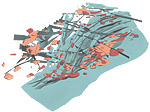3D geological and gravity inversion models of intrusive bodies in Western Victoria 2011
 |
| |||||
Product description:Note Revised edition - September, 2011. Explanatory Notes Western Victoria intrusives were modelled in two stages, based on two potential field datasets; gravity and magnetics. The gravity dataset (and its derivatives) was interrogated to outline anomalies interpreted as the response of subsurface intrusive bodies. The polygons were imported into GoCad and preliminary 3D intrusive bodies created. Where possible the original model geometries were constrained by surface mapping and forward modelled cross-sections. To refine the modelled body geometries, the western Victoria model area was divided into northern and southern regions and gravity inversions were run on each region. Initially a voxet volume was constructed consisting of a background unit with density 2.7 t/m3, and intrusive bodies with densities of 2.5 t/m3. Homogeneous property (intrusives only) inversions were run refining the average density to 2.59 t/m3 in the south, and 2.61 t/m3 in the north. Geometry inversions were subsequently run refining the body geometries while using the results of the homogenous property inversions as constraints. Heterogeneous property inversions were then run, providing a range of intrusive density values (2.38 – 2.62 t/m3). Further geometry inversions were run on the intrusives with heterogeneous property results as constraints, fine tuning the geometries. Finally heterogeneous property inversions were run on the background unit adding further insight into density distributions within the upper crust. The complex nature of the magnetic response over western Victoria, the presence of remnant magnetisation, and the varied magnetic response of intrusive bodies (and associated contact aureoles), meant that an inversion on the magnetic data was not attempted for intrusive bodies. Intrusives based on magnetic data (and its derivatives) have been modelled in much the same way as the starting bodies for gravity inversions. Numerous magnetic anomalies indicate the presence of subsurface magnetic intrusions. Other anomalies indirectly indicate the location of intrusives by highlighting contact aureoles around the intrusive bodies. Where possible model geometries were constrained by surface mapping, and informed by anomaly shape, size and amplitude. Where the modelled magnetic intrusives coincide with gravity inverted bodies, both the gravity and magnetic derived bodies are presented. Download The downloadable version of the 3D model is supplied in PDF format and is a large file (37.7MB). Explanatory notes (PDF 14KB) and 3D model attributes are also supplied (ZIP 7.7MB). | ||||||

